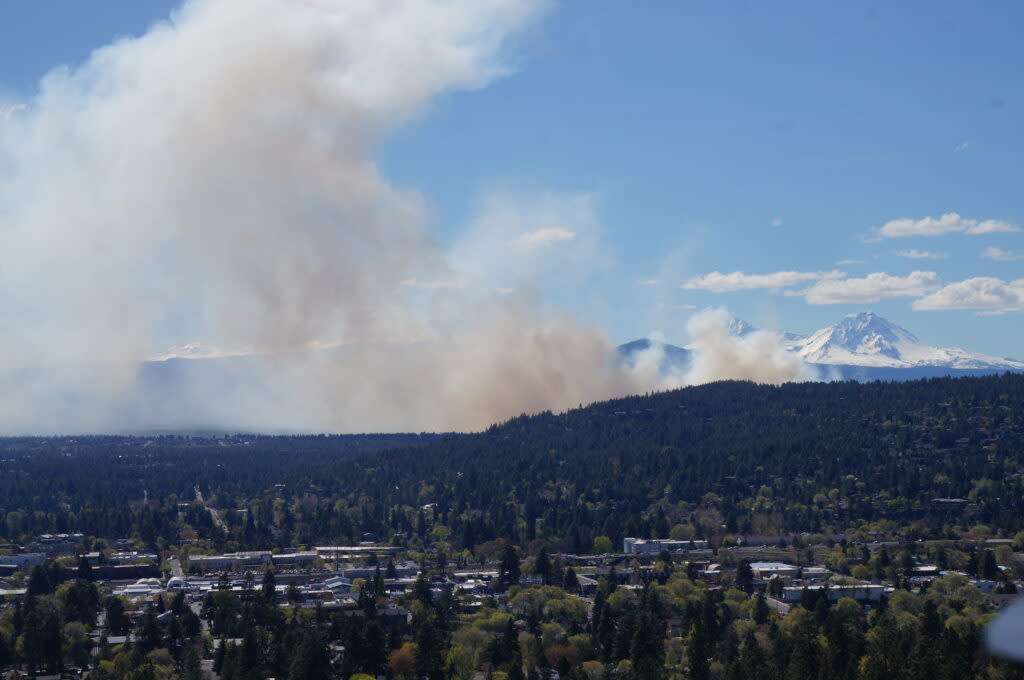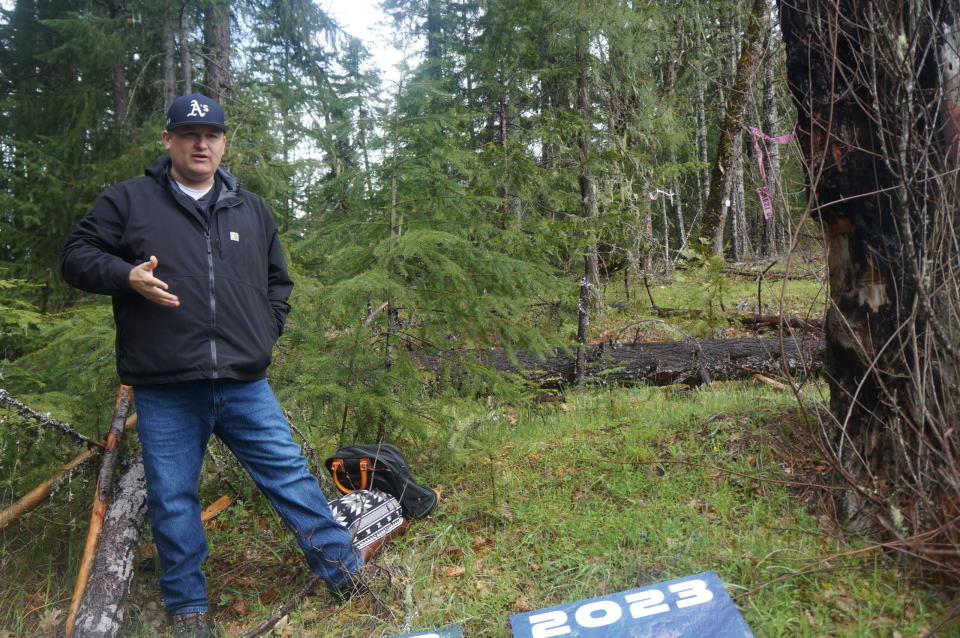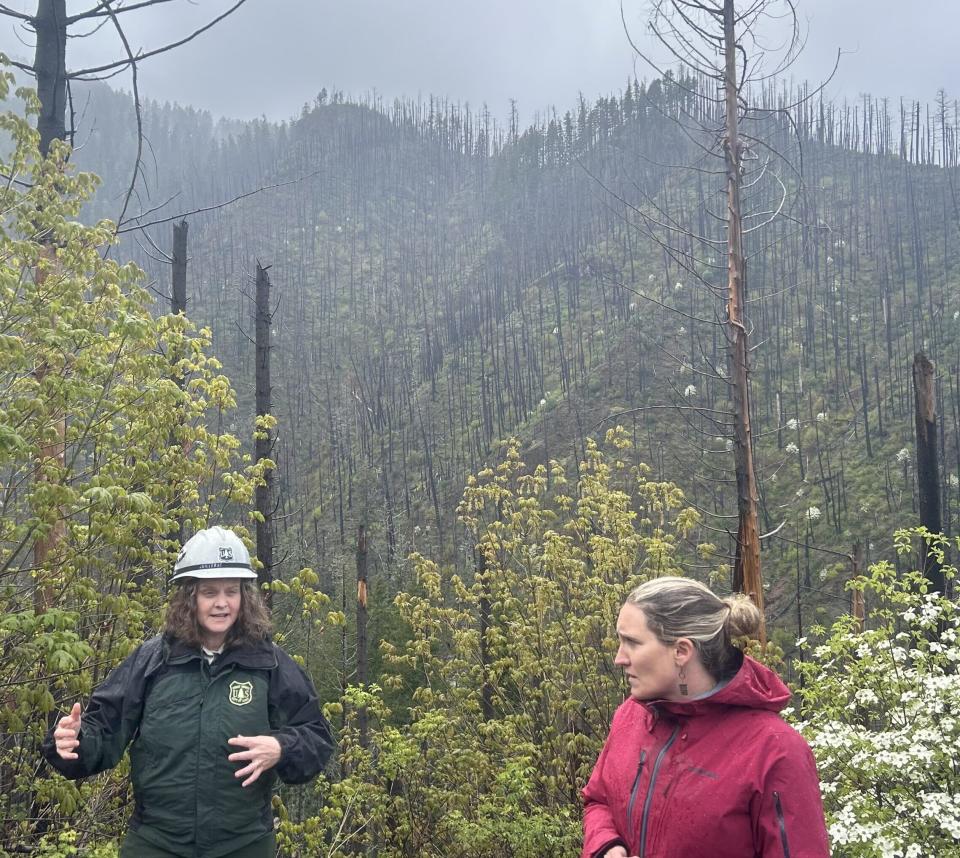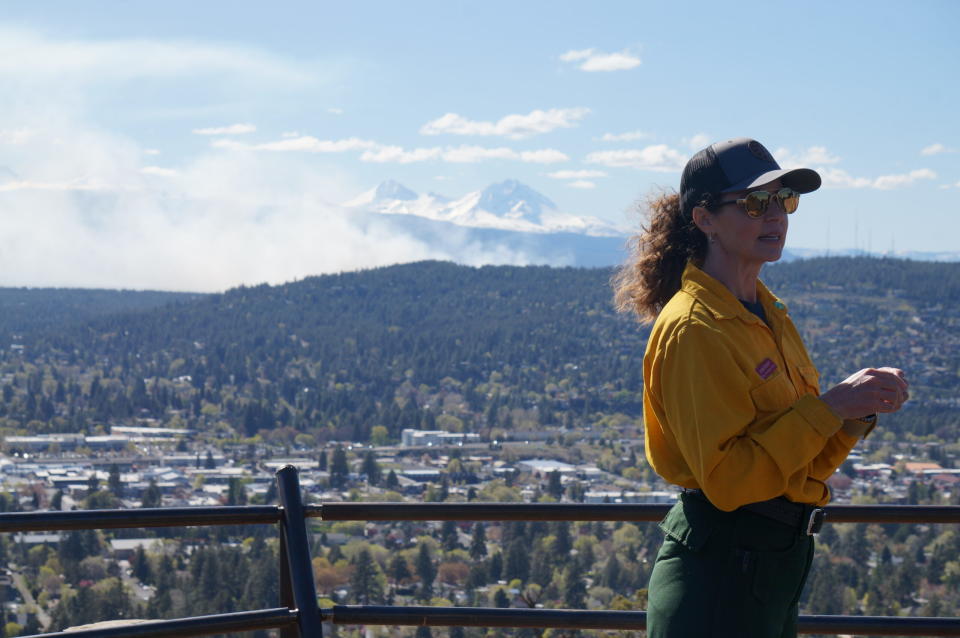Curbing severe wildfire in Oregon depends on urgency, scale of controlled burns by state and feds

- Oops!Something went wrong.Please try again later.
Officials manage a controlled burn in Bend on Thursday, May 9, 2024. Oregon wildfire officials said they are increasing the scale of prescribed burns across the state to prevent severe wildfires. (Alex Baumhardt/Oregon Capital Chronicle)
Jesse Jackson stands proudly, flute in hand, on several hundred acres of forest near Roseburg that the Cow Creek Band of Umpqua Tribe of Indians fought to get back from the federal government in 2016 after more than 160 years of private and federal management and decades of heavy logging.
Jackson, education programs manager for the tribe, offers gratitude to the land through his music and the indigenous Takelma language once spoken widely by the tribe. He describes huckleberries, thimbleberries, gooseberries and tobacco that used to grow in the area, and which he hopes will return. Then, he explains how he wants to set fire to the forest.
“Fire was major to keeping all of that stuff healthy,” he said.

He and the tribe’s foresters want to convince the federal agencies that own thousands of acres surrounding the tribe’s land to introduce some burning to those federal forests, too. A growing body of evidence from around the world corroborates what the Cow Creek and other indigenous groups have been saying for years: Starting low-severity fires across the forest floor – what’s called prescribed fire – is the most effective way to contribute to forest health and to quell the risk of severe fires, like those seen in recent years in Oregon and across the West.
But more than a century of intensive logging and development in Oregon, followed by replanting with tightly packed Douglas fir trees and years of stopping fire at all costs, has laid the groundwork for a present and future of fires that are bigger, hotter and moving faster.
For Jackson and the tribe, burning and fire have long been fundamental parts of forest regeneration that create soil health, and less density and competition among trees. Fire was to be respected and harnessed, not feared or suppressed. Controlled burning was practiced by his ancestors for tens of thousands of years to prevent severe fire and to ensure the return of keystone plants and species that provided fibers and food.
We’ve burned here since time immemorial. Anthropologists and archaeologists would say that we burned here for 20,000 to 40,000 years. I’ll cross the line and say that the feds have definitely messed up in the last 200 years by not continuing land practices that we're here for – minimally – 20,000 to 40,000 years
– Jesse Jackson, education programs manager, Cow Creek Band of Umpqua Tribe of Indians
Fire experts at state and federal agencies are coming around to some controlled fires. They agree broadly that prescribed burning needs to happen across millions of acres nationwide, and it needs to happen fast. A sense of urgency is growing among those in the U.S. Forest Service, the Bureau of Land Management and the Oregon Department of Forestry to undertake burning on more acreage, especially near cities and towns, to keep catastrophic fires from reaching areas where people, homes and communities could be lost. But with any fire comes smoke and the risk of flames spreading across property boundaries, making public acceptance of such a sweeping fire mitigation strategy difficult.
And the forest service has not given up on trying to suppress all wildfire, meaning forests overdue for some low-severity fire won’t get it, and could instead build up fuels feeding more severe and uncontrollable conflagrations.
Living with fire
North of Roseburg, in the town of Oakridge, four severe wildfires during the last decade have changed locals’ relationship to smoke and controlled burns.
“People now welcome prescribed burning to reduce hazardous fuels,” said Sarah Altemus-Pope, head of the South Willamette Forest Collaborative, a group convening nonprofits, state and federal forest agencies and community members to prepare and respond to wildfires in the former timber town surrounded by the Willamette National Forest.

Sarah Altemus-Pope, head of the South Willamette Forest Collaborative (right) in front of part of the forest that burned in a 2014 wildfire. (Alex Baumhardt/Oregon Capital Chronicle)
The turning point for Altemus-Pope and the town of 3,100 came in 2022, when the Cedar Creek Fire moved too close for comfort. It lasted for three months, burned 127,000 acres and eventually led to a temporary evacuation of the entire town for several days. Residents spent nearly a month with air quality so poor it was considered among the worst in the world at the time, she said.
Altemus-Pope, a former firefighter and smokejumper in Montana who grew up in Oakridge, helped forge partnerships with state and federal agencies for strategic thinning and burning around the city to make the landscape safer for firefighters to enter and secured funding for air conditioners and air filtration systems for low-income and elderly residents for smoky days. With funding from the Oregon Department of Environmental Quality, the collaborative developed a smoke safety plan to ensure residents wouldn’t be harmed in the process of doing controlled burns.
“They realize they can have some limited exposure to smoke on their terms, or it can be lots of uncontrollable smoke from severe fires,” she said.
In Oregon’s recreation capital, Bend, this level of acceptance is beginning to sink in. The city is right up against the Deschutes National Forest and is dense with ponderosa and lodgepole pines that would have historically experienced low-intensity fire every five to ten years. Suppression over the last century has made much of the area around the city a tinderbox.
Controlled burns help. On a Thursday in mid-May, the U.S. Forest Service burned 350 acres on private land near the forest to reduce fire risk. It was timed to ensure it would not last more than a day and that the wind would carry most of the smoke beyond the most populous parts of the city.

But the scale of such burning needs to accelerate to reduce fire risk near cities, and it can take up to eight years of planning before a prescribed burn takes place, said Jodie Barram, co-coordinator of Oregon Living With Fire, a multi-agency collaborative among local, state and federal governments.
The forest service has to undertake a National Environmental Policy Act assessment, or NEPA assessment, to ensure critical habitat won’t be harmed and that myriad public and forest health needs are considered. It could take another one to three years to finish mowing and mechanical thinning done in advance of a burn, often undertaken by logging companies that are allowed to take some marketable timber along with the smaller trees and plants they remove.
There’s also a load of information that state and federal agencies have to get out to area residents in advance of a burn and a near-constant need for more staff and competition to get firefighters to assist, and who are often pulled away to fight non-controlled fires. By the time everything is ready, the forest service could have a window of a few hours or a few days to do a burn given wind and weather conditions.
Last spring, the forest service was able to complete controlled burns on 4,400 acres of the 1.6 million acre Deschutes National Forest. So far this year, it has burned about 800 acres.
When it comes to suppression, the forest service has not made much progress. Despite the abundance of research showing forests must burn sometimes to maintain their health and diversity, the forest service continues to target keeping 98% of wildfires under 10 acres or less.
Back on the Cow Creek’s forestland, such an attitude toward fire control reflects the shortcomings of modern attitudes toward fire, according to Jackson. But it’s not stopping the tribe from trying to bring the forest service onboard for a controlled, large-scale, cross-border burn across hundreds of acres in the area to keep their forests and surrounding forests healthy and fire resilient. If approved, it’s possible the tribe could conduct among the first and largest cross-border prescribed burns in Oregon in the next few years.
“We’ve burned here since time immemorial,” Jackson said. “Anthropologists and archaeologists would say that we burned here for 20,000 to 40,000 years. I’ll cross the line and say that the feds have definitely messed up in the last 200 years by not continuing land practices that we’re here for – minimally – 20,000 to 40,000 years,” Jackson said.
Reporting for this story was made possible with a fellowship from the nonprofit Institute for Journalism and Natural Resources.
GET THE MORNING HEADLINES DELIVERED TO YOUR INBOX
The post Curbing severe wildfire in Oregon depends on urgency, scale of controlled burns by state and feds appeared first on Oregon Capital Chronicle.

